(from the 2008 archives)
Note: This is Part one of ‘A Sentimental Tour.’ It was first written in 2008 and is re-published here. Look for the sequel or sequels to it in upcoming issues of the Zephyr…
The demise of Dewey Bridge came like a hammer blow between the eyes to many of us. It became another one of those lost links to the past. For a guy allegedly “clinging hopelessly” to it, I was particularly saddened.
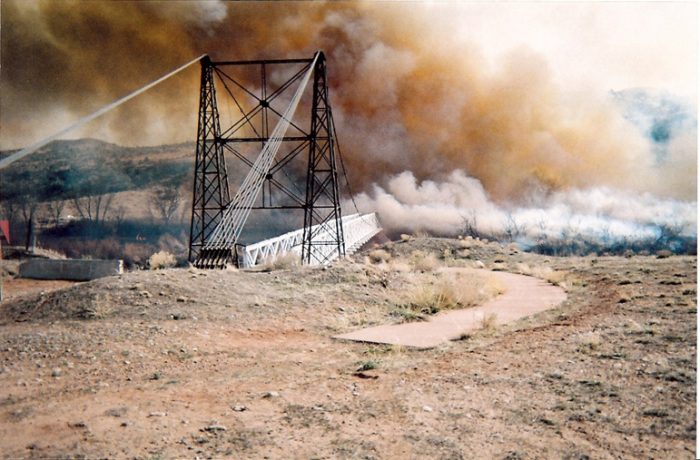
But I found myself thinking once again of all the other changes this part of the world has experienced, just in the few decades I’ve been here. Faces and places. Gone but not forgotten, at least not by me. And lest any of you dare to forget, let me either remind you, or introduce you to some remarkable people and memorable sights. When I think of the Moab I loved, these are some of the images that come to mind…
TOM ARNOLD…VW MECHANIC/PHILOSOPHER
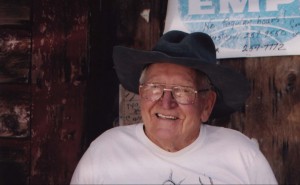
He was TK to many of his friends. Tom Tom to others. He was one of the first people I met when I moved to Moab. He reminded me of Frank Morgan, the actor who played the title role in “The Wizard of Oz.”
His “Volkswagon Museum,” (some call it a junk yard) was a thorn in the side of obsessive-compulsive people everywhere. No one would ever call it tidy. The interior of his shop was even worse. In the last decade of TK’s life, the place was a refuge for dozens of stray cats. Tom had them neutered and then turned them loose. They could count on him for a free meal.
Tom Arnold was Ed Abbey’s personal pilot in the 70s, when Ed lived in Moab. Abbey refused to put a phone in his house on Spanish Valley Drive, but it was a two minute drive to Tom Tom’s shop where he spent countless hours arguing with editors and agents.
Tom Arnold was a notoriously successful poker player. A few years ago, he revealed to me his secret: “I was the only one at the table who was sober by 10 pm.”
More than anything, he was “cheerful in all weathers,” to steal a line from Larry McMurtry. The man was unflappable. When Tom Arnold died last year, Moab’s light dimmed.
THE BIG TREE
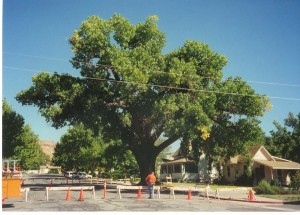
In the late 1880s, a cottonwood seedling was planted at the corner of First South and Third East. Records at the Grand County Courthouse indicate that a man named Leonidas L.Crapo filed on the land the previous November, as a homestead property, but no one can say for sure who planted the tree.
The tree may have gone into shock from its sudden unearthing and relocation. Her leaves might have begun to show signs of stress and wither in the late spring heat. But with loving care and enough water, the cottonwood survived and began to grow, quite slowly at first, and the planter might have wondered in those early years if the tree would ever provide decent shade on a scorching July day. But as the century drew to a close, the tree’s roots had reached deep into the sandy soil of the Moab Valley and tapped into the underground aquifer. The cottonwood tree took off. By the 1920s, Moab residents were already referring to it as “The Big Tree.” No one had to ask, “Which ‘big tree’?” Among great trees, the First South cottonwood was the greatest. The Big Tree became a reference point for Moabites and especially for new arrivals.
Almost a century after it found a new home on First South, I saw the Big Tree for the first time. I still recall its gigantic gnarled old trunk—-each lump and bump and scar looked as if it had a story to tell—-but more than anything I remember the cool shadiness it provided, even on a hot August afternoon. I stood beneath the Big Tree and gazed skyward at its soft green translucence as light filtered through branch after leafy branch.
In the 80s, there were some proposals to prune the tree back dramatically–some of its branches had become enormous, and the Big Tree was becoming dangerously top-heavy, but many of us “environmentalists” vigorously objected, including me. We thought it would have been a desecration of this venerable old Moab resident. The pruners backed off.
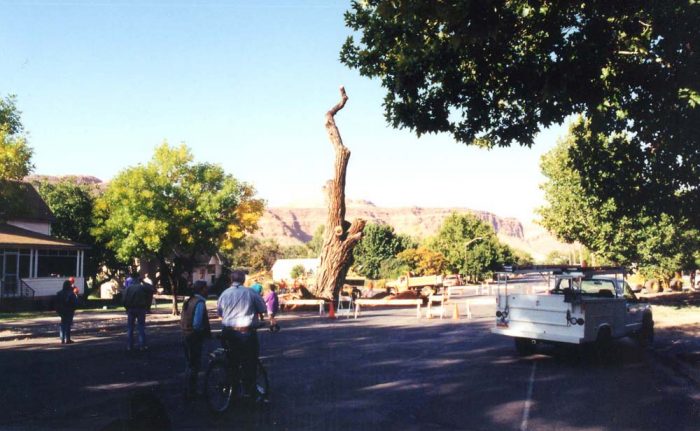
On a brilliant mild afternoon in late autumn, just a few weeks before the Millennium, the Big Tree on First South began to uproot itself. The sidewalk buckled and split in two as the cottonwood’s massive root system slowly lost its grip on the good earth that had sustained her for more than a century. Within the space of a few hours, the tree was visibly tilting toward the street. The news rippled from one end of Moab to the other and by sunset, scores of Moabites had gathered to watch and to mourn. City work crews, fearing the tree might topple completely, blocked traffic in both directions and sought advice from tree specialists at the University of Utah. They drove down from Salt Lake City the next day but it only took a short while to assess the Big Tree’s future—-she was going to die. The city decided to put it out of its misery.
A few weeks later, work crews dismembered the Big Tree, one limb at a time, until there was nothing left. The ground was re-contoured, new curbing was installed and by Thanksgiving, a newcomer passing by would have had no clue of what had been a Moab Landmark for more than a century.
THE POPLAR PLACE FIRE and the MAN WHO SAVED IT
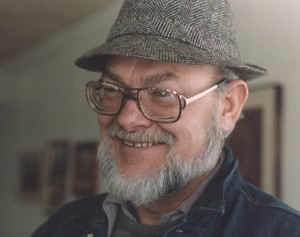
In the 70s and 80s, the vortex of Moab social life was the Poplar Place, at the corner of Main Street and First North. The building had been there for almost a century but had been a bar only since the 60s. Of all the “regular customers” at the Pop, the image of Dave May, the Chief Interpreter at Canyonlands National Park, standing nightly at the end of the bar with a stack of quarters, registers most clearly in my mind. He was a good guy.
One night in the late 80s, a fire broke out in the middle of the night, but went undetected for hours. Finally the roof literally exploded in a ball of fire and the innards of the bar were gutted. Nothing remained of the Poplar Place except the four brick exterior walls and they had been so badly weakened by the blaze that they could no longer support any kind of structural load.
The logical next step should have been to bulldoze the bricks and start over. It would probably have been cheaper as well. But the owner, Joe Kingsley, could not bring himself to give the order. Instead, he literally built a new bar within the four walls. If you look closely, you can see huge vertical beams inside the building that bear all the weight of the second floor and the roof.
Thanks to Joe, at least a part of the Poplar Place survived.
MAROONEY
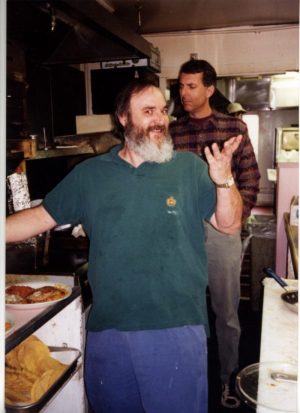
He was here so briefly—just a few short years in the 90s—but Michael Marooney left an indelible impression, one way or the other, on everyone who met him. He bought the Dos Amigos Mexican Cantina, restored quality to the menu, did a huge business, but gave away too many free meals (“Hey, only suckers pay!”), did much of the cooking himself (“Hey I got chicken on my fingers!”), drank too much of his liquor stocks, insulted almost all his customers, and usually got away with it.
He once mildly sexually harassed a woman who worked for one of the shipping companies. Better not to be specific. A representative of the company showed up and warned Marooney they might quit delivering to his restaurant.
“Look,” Marooney said, “I’m a fat asshole. I’m an idiot.”
The man nodded.
“But I sexually harass everybody!”
I just happened to walk into the Dos as he was explaining himself to the man.
“Hey Stiles,” he called. “Didn’t I sexually harass you just the other day?”
I thought a moment. “That’s right. You tried to goose me…I wish you’d stop that Marooney.”
Marooney turned to the man triumphantly, “See? I’m an equal opportunity sexual harasser. I harass regardless of race, color, creed or gender.”
The man shook his head and laughed. “Okay. Just quit goosing our employee.”
He raised his hand solemnly, “My goosing days are over.”
When Mike moved away in the late 90s, some mourned his departure, others wanted to kill him, but he was not soon forgotten. Today he lives in California, sells Mercedes Benz luxury cars and still occasionally sends me emails with attachments that I’m often afraid to open.
DEMISE of the CANYONLANDS CAFÉ
For decades Moab had three greasy spoon cafes to choose from—Milt’s Stop n’ Eat, the Westerner Grill, and the Canyonlands Café. They were also the source of limitless information and gossip. My first Moab meal was at the Café. The counter was conducive to conversation.
The winter of 92-93 saw the end of the Canyonlands Café. It was the winter that Moab began its transformation from a rural town to an urban population center. From one end of Main Street to the other, empty lots became building sites. Seven motels sprouted in three months. Old buildings came down. New buildings went up. The sight of particle board buildings stretched to the horizon line.
Among the casualties was the Café.
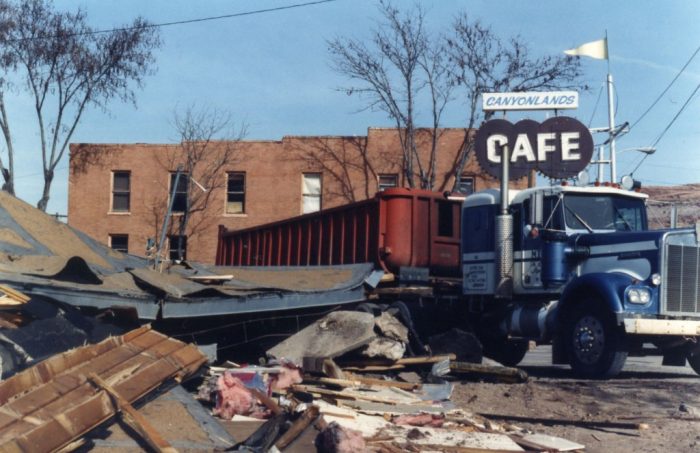
ROCKY NEWELL….AHEAD of his TIME
Rocky Newell was the “Father of Recycling” in Moab. He did it partly for the money (“Jimbo, if I can’t make an extra $3000 a year from junk and garbage, it’s a bad year.”). But it was more than that–he couldn’t bear to see anything thrown away that could be fixed. He went to the dump regularly and came home with everything from broken toasters to vacuum cleaners. He could repair almost anything and then Rocky sold them at his yard sales.
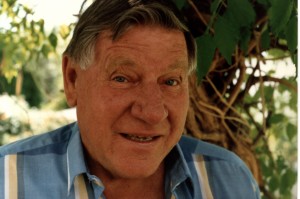
When he went to work as a maintenance man at Arches National Park, there was no recycling program there at all. Rocky found an old garbage can, I routed a “Please put your aluminum here” sign for him, and Rocky started collecting cans. But the recycle bin was not enough. During his lunch hours, Rocky would climb into the park garbage truck and find the extra aluminum from the park visitors who had missed the bin.
And when he checked the campground trash cans, Rocky retrieved anything he thought salvageable. And he believed in sharing. He dropped a fair number of Coleman stoves and sleeping bags at the Devils Garden trailer, which I appreciated. But when he started delivering semi-fresh fruits, vegetables and meat products, I became a bit skeptical.
“There’s not a damn thing wrong with this food!” Rocky would protest, and I’d meekly agree. Later, I figured, I’d just throw it in the trash, which was really stupid because he’d find it the next day. Ultimately, I learned to take Rocky’s food contributions far out into Salt Valley and several hundred feet from the road.
THE DEMISE of the DELICATE ARCH SWINGING BRIDGE
Dewey Bridge hasn’t been the only suspension bridge in Grand County to meet an untimely end. For almost half a century, this swinging foot bridge over Salt Wash served hundreds of thousands of hikers to Delicate Arch at Arches National Park. The bridge was built in the 1950s and there is reason to believe Ed Abbey may have helped in its construction.
Though the wooden planks were washed away by numerous flash floods over the years, the two steel towers and the cables always managed to survive. It was usually a three or four day job for the maintenance crew at the park to replace the floor planks and put the bridge back into operation again.
A few years ago, however, the National Park Service decided to replace the old swing bridge with a more “permanent” structure. At a cost of several hundred thousand dollars, the new bridge could still not withstand the floods and the trail was closed for weeks in 2006.
LAST DAYS at OLD CITY MARKET
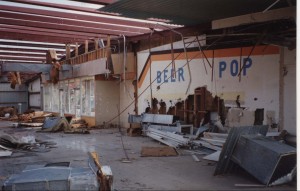
Until 1991, City Market resided across the street and a block or so north of the current store. Its size seemed more than adequate for a town Moab’s size. When the new store opened, we couldn’t find a damn thing and we marveled at the ridiculous size of the parking lot, which was three or four times larger than the one we were used to.
“They’ll never fill that lot up,” we complained. “What a waste of asphalt.”
We had forgotten the old adage, “Goldfish grow to the size of the bowl.” By 2000, people were complaining it was too small.
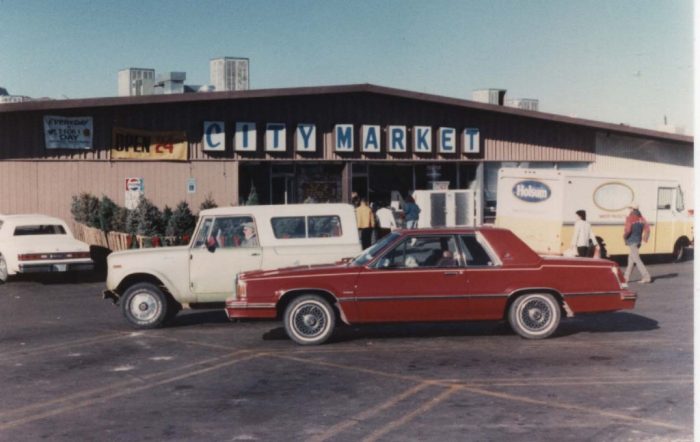
IN THE BEGINNING there was MILT’S STOP & EAT
Milt and Audrey Galbraith opened their “Milt’s Stop n’ Eat” on Labor day in 1954. He arrived just as the Uranium Boom was transforming the town. He borrowed the money to build the small diner on a handshake and the story goes that he paid off the debt in a year.
At the time, Main Street ended at Center Street, To go south the highway went east to 400 East, then past Milt’s on Mill Creek Drive. Milt was there, 24 hours a day, seven days a week in the beginning. He slept on a cot, willing to be rousted from sleep for a lonely trucker at 2 am.
Milt and Audrey ran the café until the late 70s.
Milt was known for his Chili cheeseburgers and his magnificent Denver Specials. He served his last Special with as much pride as the first.
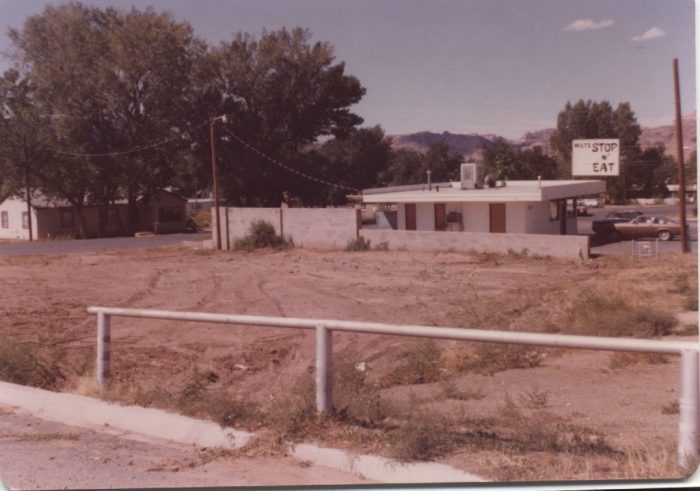
JIM CORWIN, THE FLEXIBLE CABLE GUY
For years there was actually a cable company in Moab with real people who you could actually see and talk to. They even answered the phone. Jim Corwin was the manager of the cable company here and one of the first Zephyr advertisers.
Because of its remote location, Moab has always needed cable television service—it’s been cable or nothing at all since the beginning. For years we were limited to the three commercial affiliates in Salt Lake City and KUED, the public TV station. By the mid-80s, however, our selection began to expand a bit. In 1988, Moab received the A & E channel, but only after 4 pm. That channel was occupied by C-SPAN 2 until then.
In November I read that A & E planned to re-broadcast the NBC video tapes of the assassination of President Kennedy, in real time, just as the events unfolded on November 22, 1963. As a dyed-in-the-wool JFK conspiracy buff, I was desperate to see this program. But it was to start airing at noon.
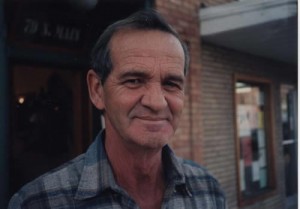
I tracked down Corwin, the day before the broadcast, and explained my dilemma. Jim shrugged.
“What the hell,” he said. “I’ll just flip the receiver over to A & E early today. Nobody will ever know.”
True to his word, C-SPAN stopped and A & E began broadcasting just before noon. I taped all four hours and still have them, to this day.
Can you imagine being able to work out an arrangement like that with a cable company in 2008?
KEN DAVEY, the DEAN of the MOAB PRESS CORPS
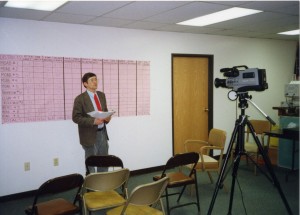
In the early 1990s, Ken Davey was the Voice of Moab. He was the news director for Channel 6 News, the senior reporter for the Moab Times-Independent, and a featured columnist/essayist for The Zephyr. His dry wit and edgy sense of humor drove all of us insane at one time or another, but he never drove all of us crazy at the same time, so he was able to successfully multi-task for years.
2019 Editors Note: Ken Davey passed away in December of 2017. He wrote for The Zephyr, off and on, for over a decade. I nicknamed him, “The Dean of the Moab Press Corps,” when he found himself working simultaneously for the local weekly, the radio station and The Zephyr. He was a caring and principled journalist. His “Facts and Opinions” articles for the Z always represented to me—and still do—the best and most honest kind of local journalism that any of us can hope for…JS
SOMETHING MISSING THAT I CAN’T COMPLAIN ABOUT
When it was first proposed to build a scenic tram up the side of the Portal, I was sure it would never happen. And when it was built I was just as sure that it would be there forever. I was wrong on both counts.
The company that built the chairlift expected it to be a huge commercial success, with a projected visitation of 250,000 paid customers within a few years. In reality, the numbers fell far short. The tram went into bankruptcy, the tram was sold for pennies on the dollar and the new owner couldn’t turn a profit either.
Finally the Nature Conservancy bought it and, taking a lesson from Jennifer Speers, tore it down in one afternoon.
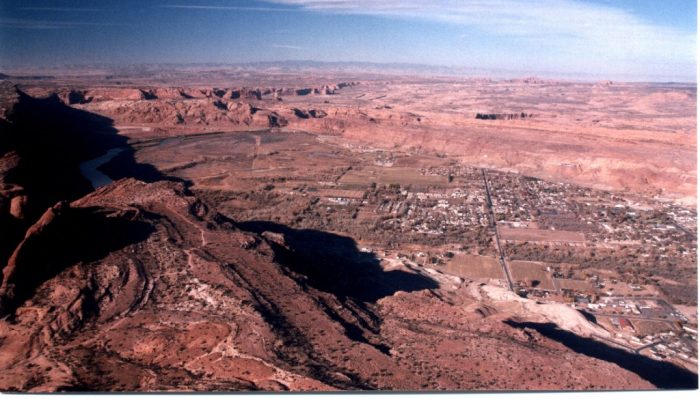
Moab in the second decade of the 21st Century bears little resemblance to the sleepy quirky town we once loved. Some will argue that it’s a better place now–that it has more ‘amenities’ and more culture. That its population is more ‘progressive’ and they may be right.
But to paraphrase Abbey…”They will never know what we knew. They will never feel what we felt.”
From the 2008 Zephyr Archives.
Jim Stiles is the Founder and Co-Publisher of the Canyon Country Zephyr.
To comment, scroll to the bottom of the page.
Don’t forget the Zephyr ads! All links are hot!

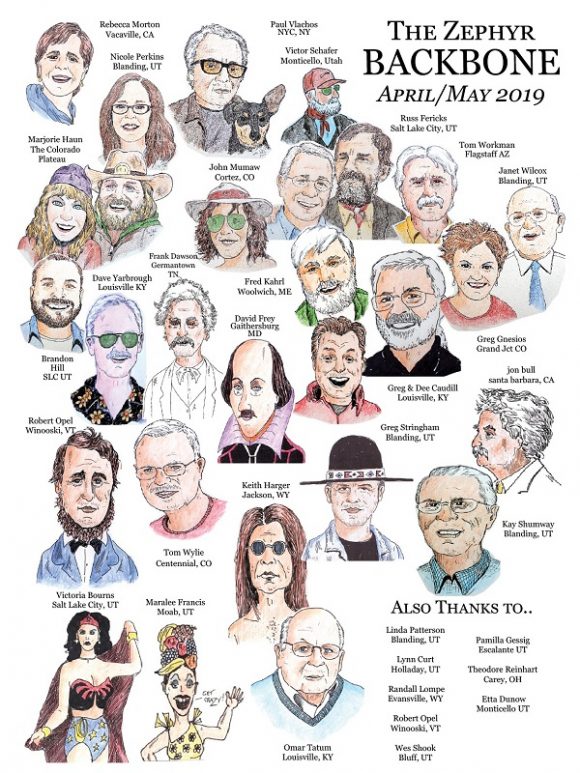


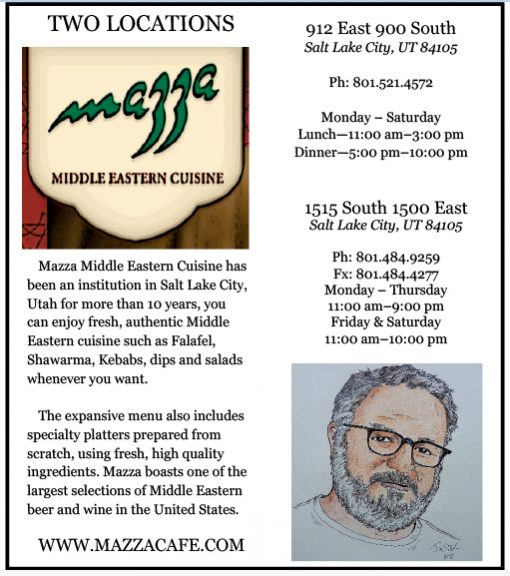
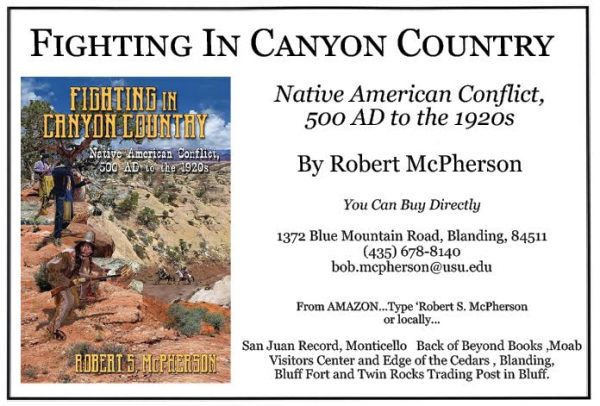





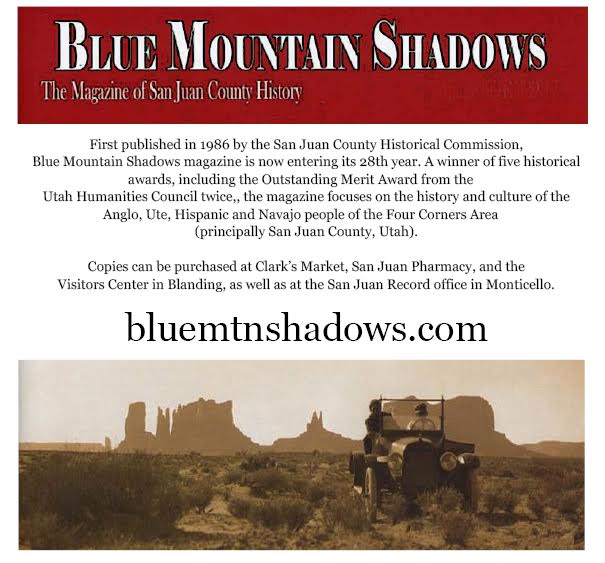
The “Tour” stirred many many memories of my youth and the beautiful love of my life, Peggy Ann Shupe that became my wife…. Peggy passed away December 17 – 2018 leaving my heart broken and so sad.
https://www.farmingtonfuneral.com/notices/Peggy-Miller
I believe my grandfather, Robert Clark, planted the “Big Tree”.. I was raised in its shadow in the big white house, and the division of the big roots was my “playhouse”. The story around town was that my mother, Neva Kirk, loved the tree and protected it from being damaged. In truth, my Mother disliked the tree, because it was dirty. It leaked sap all over the cars, etc., and it had bugs and caterpillars. . She eventually arranged for the City to take it over;, trim it, etc.
The clock that ran backwards at the Westerner Grill. I made me believe in the magic of Moab, until it was gone, way too soon.
So much has changed, so many loved ones gone. I suppose change is inevitable. My intro to the Moab community came through Big Linda, my Aunt. I miss her so much. It doesnt seem like home here anymore, and so we retreat, to less populated areas…Thompson, L asal, myself, to Eastland, deep in the trees. And someday, God forbid, these places will be over run, too.
I know all too well everyone and everything in this article..
I lived in the ” little house under the big tree” for years..
good times back in the day..
Too bad ed Abby wrote a book about Moab and ruined it..
But to paraphrase Abbey…”They will never know what we knew. They will never feel what we felt.”
Abbey took that quote from Tex McClatchy.